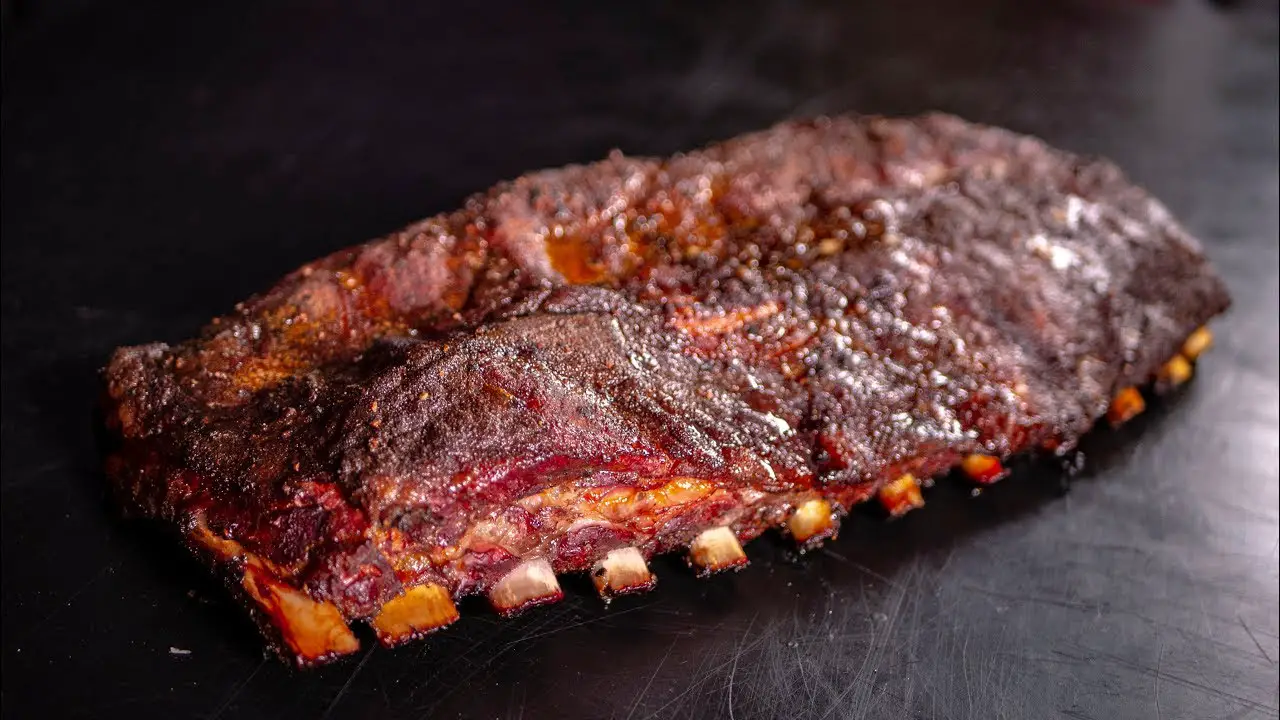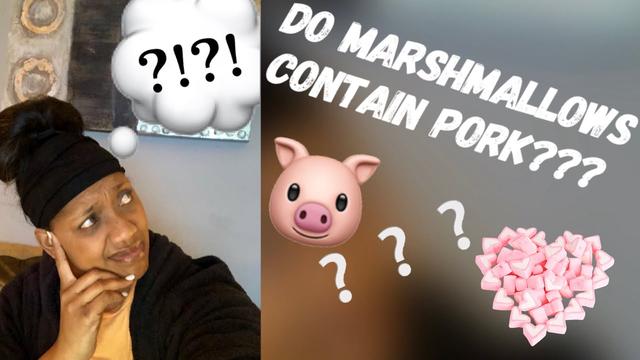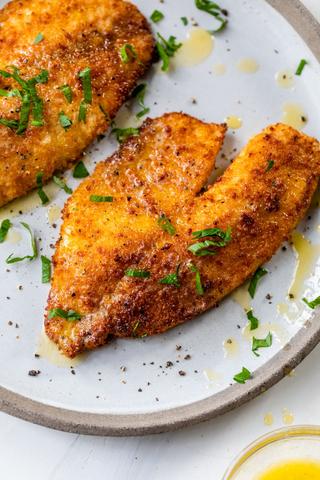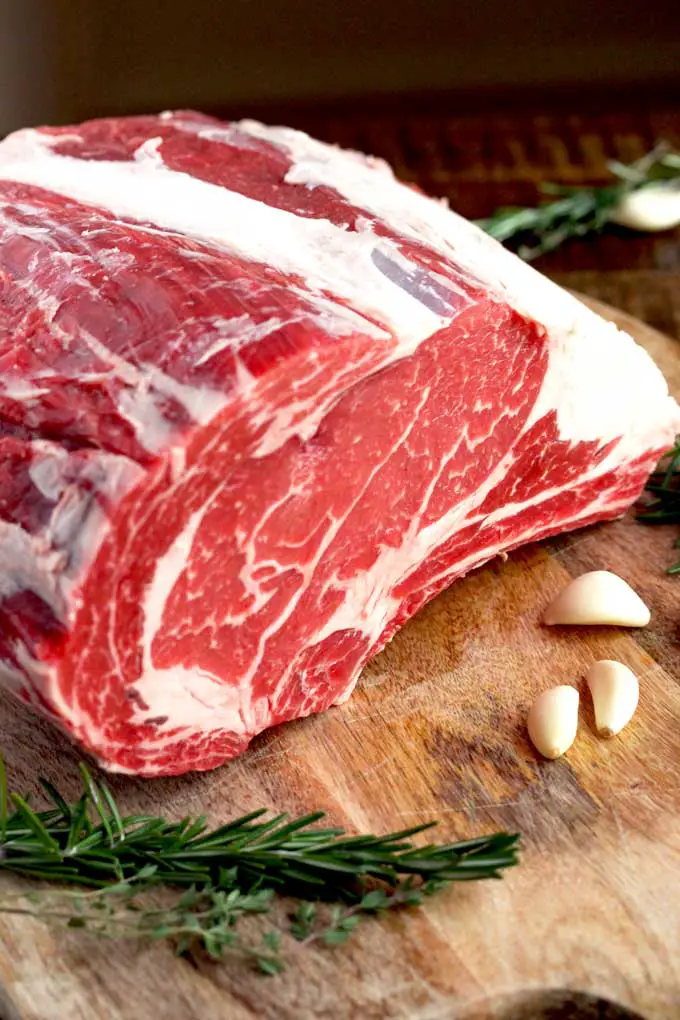
“Unveiling the Prime Rib Location on Cow: A Fascinating Insight into the Culinary Delight’s Origin and Cut Placement!”
What is Prime Rib Roast? Location, Types, and More

Prime rib is a popular choice for holiday meals, particularly Christmas. It is a large and expensive cut of meat, typically consisting of the upper rib bones (ribs 6-12). However, it can also be sold as a standing rib roast, which includes the entire rib primal (7 bones). There are two types of prime rib – first cut and second cut – based on the muscles that make up the roast.
The first cut prime rib is taken from closer to the loin and contains larger “eye” muscles. It is more desirable for many consumers who prefer a larger portion of lean meat. On the other hand, the second cut prime rib is taken from closer to the chuck and has larger “cap” musculature and smaller eye muscles. It may have pockets of fat within the lean meat.
It’s important to note that prime rib does not need to be graded as “prime” by the USDA. The term “prime rib” refers to this specific area of the cow, which has a thick fat cap and heavily marbled meat. Retailers can label their cuts as “prime rib roast” regardless of its grade. When cooking prime rib, it is common to sear it first and then roast it until medium-rare.
Prime Rib Location on the Cow

The prime rib is located in the upper rib bones of the cow, specifically ribs 6-12. It is part of the rib primal, which is the entire rib section. A whole prime rib can weigh anywhere from 14-22 lbs and consists of seven bones. However, it is more common to find prime rib sold as two cuts: first cut and second cut.
The main difference between first cut and second cut prime rib lies in the muscle composition. The first cut is taken from closer to the loin and contains larger “eye” muscles, such as the longissimus dorsi (ribeye muscle). It also has a smaller portion of the intensely marbled and tender “cap” muscle. On the other hand, the second cut is taken from closer to the chuck and has bigger “cap” musculature with smaller eye musculature.
No, prime rib does not necessarily mean that the beef is graded “prime” by the USDA. While prime rib is considered prime because it has a thick fat cap and heavily marbled meat, it does not have to be derived from USDA grade beef. Retailers can name cuts of meat as “prime rib roast” without it being graded as “prime” by USDA standards.
What is Prime Rib?
Prime rib is a popular cut of beef that is often enjoyed during holidays, such as Christmas. It is a large piece of meat that comes from the upper rib bones, specifically ribs 6-12. While a whole prime rib can weigh anywhere from 14-22 lbs and be quite expensive, it is often sold as two cuts: first and second cut.
The difference between the first and second cut of prime rib lies in the muscle composition. The first cut is taken from closer to the loin and contains larger “eye” muscles, making it more desirable for most consumers. On the other hand, the second cut is taken from closer to the chuck and has bigger “cap” musculature and smaller eye musculature.
Contrary to popular belief, prime rib does not have to be graded “prime” by the USDA. This designation refers to the quality of marbling in the meat and its tenderness. However, prime rib is considered prime due to its thick fat cap and heavily marbled meat. Retailers can use various names for prime rib, including “prime rib roast.”
To cook prime rib, it is common to sear it first and then slow roast it in the oven until medium-rare. A general guideline for serving size is around 1/2 – 3/4 lb of cooked meat per person, accounting for shrinkage during cooking. The bones in prime rib also contribute to its name as a “standing” rib roast since they elevate the meat off the cooking container.
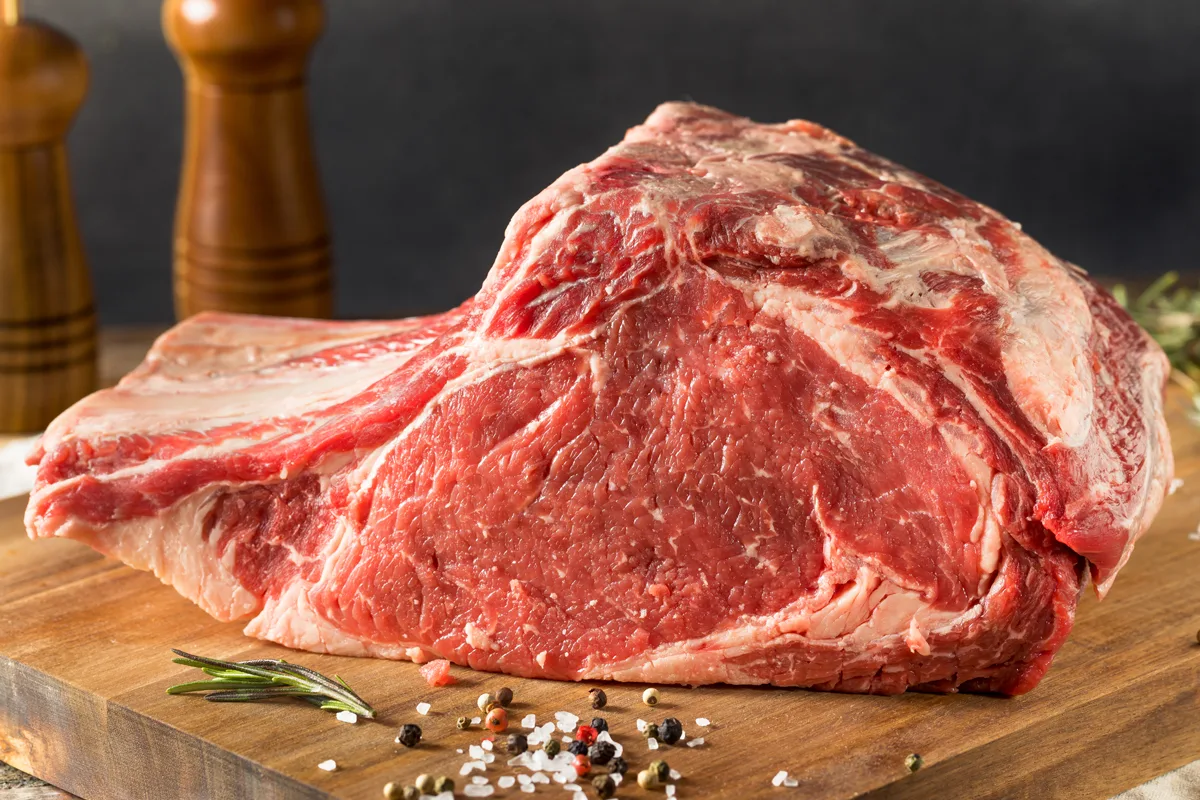
Longissimus Dorsi – The “Eye” of the Ribeye
The longissimus dorsi is an important muscle in the prime rib cut. It is often referred to as the “eye” of the ribeye because it is highly desired by those who enjoy ribeye steak. When people choose prime rib, they typically want to maximize the size of this muscle. The longissimus dorsi muscle can vary in size depending on which part of the rib it is taken from. Towards the loin, it is larger, while towards the chuck, it is smaller.
For those who really enjoy ribeye steak, the ribeye cap muscle is often their favorite. It is intensely marbled and incredibly tender. In a prime rib roast, this muscle becomes smaller towards the loin but is still present. Some people even prefer “chuck eye” steaks that come from ribs 2-5 and do not contain any ribeye muscles.
The first cut prime rib is generally more desirable for most consumers. This cut comes from closer to the loin and consists of larger “eye” muscles. If you were to get a first cut prime rib, you would have a three-bone roast containing ribs 10, 11, and 12 as a whole roast.
The second cut prime rib is usually considered less desirable compared to the first cut. This cut comes from closer to the chuck and has bigger cap musculature and smaller eye musculature. If you were to get a second cut prime rib, you would have a three-bone roast containing ribs 6, 7, and 8 as a whole roast.
In summary, there are different cuts of prime rib based on where they are taken from the rib primal. The first cut is closer to the loin and has larger “eye” muscles, while the second cut is closer to the chuck and has bigger cap musculature. Both cuts can be delicious when cooked properly, and it ultimately comes down to personal preference.
Spinalis Dorsi – The Ribeye Cap
The ribeye cap, scientifically known as the Spinalis Dorsi, is a highly sought-after muscle in prime rib. It is intensely marbled and supremely tender, making it a favorite among ribeye steak lovers. This muscle is present in both first cut and second cut prime rib, although it becomes smaller towards the loin.
First cut prime rib is taken from closer to the loin, resulting in larger “eye” muscles. A three-bone roast of first cut prime rib typically consists of rib steaks 10, 11, and 12. In terms of muscle composition, there are no large isolated fat pockets and the longissimus dorsi (LM) muscle is quite large with more lean meat. The ribeye cap is still present but in smaller quantities compared to second cut prime rib.
Second cut prime rib is taken from closer to the chuck, resulting in larger “cap” musculature and smaller eye musculature. A three-bone roast of second cut prime rib typically consists of rib steaks 6, 7, and 8. In terms of muscle composition, there are isolated pockets of fat within the lean meat. The LM muscle is smaller while the supraspinatus (SM) muscle is bigger. The complexus (CO) muscle is also present.
Contrary to popular belief, prime rib does not have to be graded “prime” by the USDA. While this area of the cow is considered prime due to its thick fat cap and heavily marbled meat, retailers can name the cut any number of ways including “prime rib roast.” The USDA uses the ribeye muscle, specifically the meat between ribs 12 and 13, to grade beef for retail.
The goal when cooking prime rib is to develop an outer crust while keeping a warm red center throughout. The traditional method involves searing the roast first and then roasting it in the oven until medium-rare. It is recommended to estimate around 1/2 – 3/4 lb of cooked meat per person, considering the shrinkage and bone weight.
Prime rib is often referred to as a “standing” rib roast because the bones have a natural curvature that allows them to raise or stand the meat off the cooking container. If the prime rib is boneless, it is typically placed on a roasting rack for elevation. This helps distribute heat evenly and prevents the roast from sitting in its own juices.

Complexus
The complexus muscle is one of the muscles that make up the prime rib. It is similar to the ribeye cap in terms of marbling and tenderness. However, it is typically surrounded by swaths of fat, which may not be preferred by most consumers. Despite this, some people enjoy this cut and it can be found in “chuck eye” steaks that come from ribs 2-5 and do not contain ribeye muscles.
The size of the complexus muscle within the prime rib can vary based on which part of the rib it is taken from. In some ribs, such as 9, 10, 11, and 12, the complexus muscle may not even be present. On the other hand, in ribs 6, 7, and 8, it is readily apparent. The complexus muscle becomes smaller towards the loin but is still present on the meat.
In terms of a first cut or second cut prime rib, the complexus muscle plays a role in differentiating between these two types. A first cut prime rib is taken from closer to the loin and has larger “eye” muscles. This means that there is more lean meat and less isolated pockets of fat within the roast. On the other hand, a second cut prime rib is taken from closer to the chuck and has bigger “cap” musculature with smaller eye musculature. This results in more isolated pockets of fat within the lean meat.
Overall, while not everyone may prefer the complexus muscle due to its surrounding fat content, it adds variety to different cuts of prime rib and caters to individual preferences.
What is “First Cut” Prime Rib
The “first cut” prime rib refers to a specific portion of the prime rib roast that is taken from closer to the loin. This cut contains larger “eye” muscles and is considered more desirable by most consumers. When purchasing a “first cut” prime rib, you would receive a 3-bone roast containing rib steaks 10, 11, and 12 as a whole roast. The muscle composition of this cut results in less isolated pockets of fat within the lean meat and a larger size of the ribeye cap.
On the other hand, the “second cut” prime rib comes from closer to the chuck and has different muscle composition compared to the first cut. This cut features bigger “cap” musculature and smaller eye musculature. A 3-bone roast of second cut prime rib would contain rib steaks 6, 7, and 8. It has isolated pockets of fat within the lean meat, with a smaller size of the longissimus dorsi (LM) muscle but a bigger size of the spinalis dorsi (SM) muscle.
The main difference between first cut and second cut prime rib lies in their muscle composition. First cut prime ribs have larger eye muscles closer to the loin, while second cut prime ribs have bigger cap muscles closer to the chuck. The first cut is generally more desirable due to its larger size and reduced fat content compared to the second cut. However, both cuts can be cooked deliciously and offer different flavors and textures.
Contrary to popular belief, not all prime ribs need to be graded as “prime” by the USDA. The term “prime rib” does not have to be exclusively derived from USDA prime grade beef. This area of the rib is considered prime because it has a thick fat cap and features heavily marbled meat. Retailers can use different names for the cut, including “prime rib roast,” even if it is not graded as “prime.” The USDA specifically uses the ribeye muscle between ribs 12 and 13 to grade beef for retail.
When cooking prime rib, a common approach is to sear the meat first and then roast it in the oven until medium-rare. This results in an outer crust and a warm red center throughout. The recommended internal temperature for medium-rare prime rib is usually around 125-130 degrees Fahrenheit, with a resting period until it reaches about 135 degrees Fahrenheit. It’s important to consider the weight of the bones when purchasing prime rib, as it will affect the final cooked weight and portion sizes.
What is “Second Cut” Prime Rib
The “second cut” prime rib refers to a specific type of prime rib roast that is taken from closer to the chuck area of the cow. This cut has bigger “cap” musculature and smaller eye musculature compared to the “first cut” prime rib. The second cut prime rib typically includes rib steaks 6, 7, and 8 as a whole roast.
In terms of muscle composition, the second cut prime rib has isolated pockets of fat within the lean meat. The longissimus dorsi muscle (eye muscle) is smaller in size, while the spinalis dorsi muscle (ribeye cap) is larger. Additionally, the complexus muscle is present in this cut.
It’s important to note that both first and second cuts of prime rib are considered prime because they come from the rib area with a thick fat cap and heavily marbled meat. However, the first cut is generally more desirable for its larger eye muscles and relatively less fat content.
When cooking second cut prime rib, it is recommended to sear it first and then roast it at a low temperature (around 225°F) until medium-rare. This method helps develop an outer crust while maintaining a warm red center throughout the meat.
Overall, while there are different types of prime ribs available, both first and second cuts can be enjoyed depending on personal preferences and desired flavor profiles.
Does Prime Rib Mean that the Beef is Graded Prime?
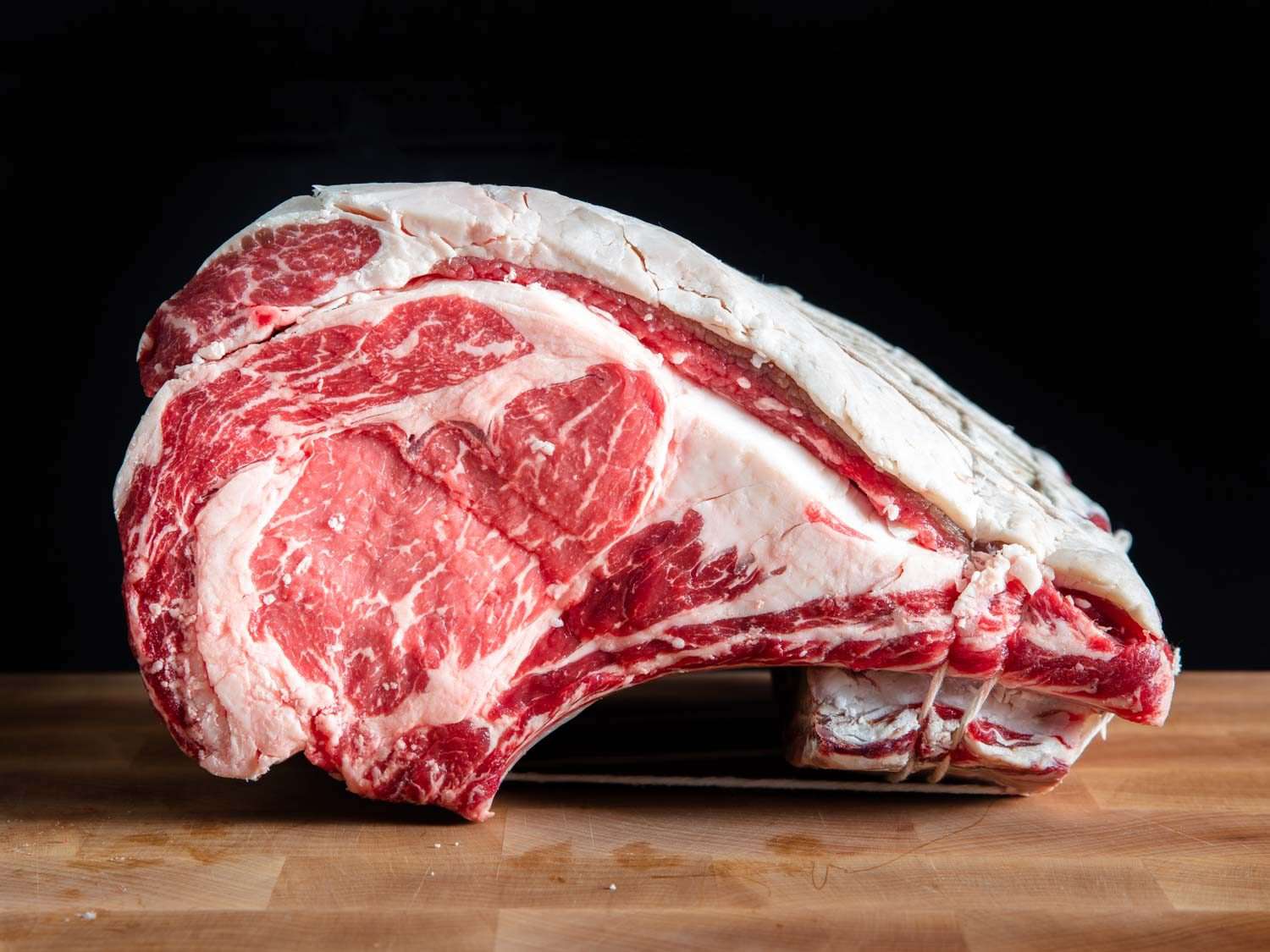
No, prime rib does not necessarily mean that the beef is graded “prime” by the USDA. The term “prime rib” refers to a specific cut of meat from the upper rib bones of the cow. This area of the rib is considered prime because it has a thick fat cap and features heavily marbled meat, but it does not have to be derived from USDA prime grade beef.
Retailers can name the cut any number of ways, including “prime rib roast,” regardless of whether it meets the criteria for USDA prime grading. It’s important to note that the USDA specifically uses the ribeye muscle between ribs 12 and 13 to grade beef for retail, highlighting its significance in determining beef quality.
Therefore, while some resources may claim that “prime rib” can only be sold if it meets the standards for USDA prime grading, this statement is incorrect. The naming and labeling of prime rib are not strictly regulated in terms of grading.
How is Prime Rib Cooked?
Prime rib is a popular choice for holiday meals, particularly on Christmas. It is a large and expensive cut of meat that comes from the upper rib bones (ribs 6-12) of the cow. However, it doesn’t have to be graded “prime” by the USDA to be considered prime rib. There are two types of prime rib – first cut and second cut.
The muscles that make up the prime rib can vary in size depending on which part of the rib they come from. The longissimus dorsi muscle, also known as the “eye” of the ribeye, is the desired muscle in prime rib as it is tender and well-marbled. The cap muscle, which is intensely marbled and tender, is also present but becomes smaller towards the loin.
First cut prime rib is taken from closer to the loin and has larger “eye” muscles. Second cut prime rib is taken from closer to the chuck and has bigger “cap” musculature and smaller eye musculature. While first cut prime rib is generally more desirable, both cuts can be delicious when cooked properly.
Contrary to popular belief, prime rib does not have to be graded “prime” by the USDA. It is considered prime because it has a thick fat cap and heavily marbled meat. Retailers can name it differently but still sell it as prime rib roast.
To cook prime rib, it is recommended to sear it first and then roast it in the oven until medium-rare. The goal is to develop an outer crust while keeping a warm red center throughout.
When estimating how much prime rib to buy for a meal, you can consider 1 rib for every two people or about 1/2 – 3/4 lb of cooked meat per person. Keep in mind that there will be some shrinkage due to moisture loss during cooking.
A standing rib roast refers to its cooking method, where the bones are used to raise the meat off the cooking container. If the prime rib is boneless, it is typically placed on a roasting rack for elevation and to prevent it from sitting in its own juices.
Overall, prime rib is a flavorful and decadent cut of meat that can be enjoyed on special occasions.
How Many Prime Ribs Per Cow?
A cow has 13 rib bones per side, resulting in two rib primals per half carcass of beef. This means that there are typically two, 7-bone rib roasts (ribs 6-12) per cow. Each rib roast can be split into 3 bone, first cut and second cut prime ribs, resulting in a total of four prime ribs per cow.
It is important to note that most rib roasts are 3-bone cuts, but they can be butchered to be 3, 4, 5, 6, or even 7 bone roasts depending on individual preferences and needs.
Other Names for Prime Rib
Prime rib is also commonly referred to as standing rib roast, rib roast, or simply as ribeye.
These names all describe the same cut of meat from the upper rib bones (ribs 6-12) of the cow.
The term “prime rib” specifically refers to the fact that this area of the rib is considered prime due to its thick fat cap and heavily marbled meat.
Retailers may use any of these names interchangeably to market and sell prime rib.

How Much Prime Rib Per Person?
When planning how much prime rib to serve per person, it’s important to consider that the roast will lose moisture and weight during cooking. On average, you can estimate about 10-20% shrinkage. Additionally, you’re also paying for the weight of the bones.
A general guideline is to allocate about 1/2 to 3/4 pound of cooked meat per person when prime rib is the star of the meal. Keep in mind that this estimate includes the weight of the bones. For example, an 8-pound prime rib could end up weighing approximately 6.5 pounds after trimming and shrinkage, resulting in about 2.16 pounds of cooked meat per bone.
Even with individuals with hearty appetites, there is typically more than enough meat with a standard 3-bone prime rib roast. It’s always a good idea to have leftovers as well, so plan accordingly based on your guests’ preferences and appetites.
Should the Prime Rib Be Bone Up or Down?
The question of whether the prime rib should be bone up or down is a common one among cooks. There are differing opinions on this matter, but ultimately it comes down to personal preference.
Some people argue that cooking the prime rib with the bone side down allows for better heat circulation and more even cooking. The bones act as a natural rack, elevating the meat and allowing hot air to circulate around it. This can result in a more evenly cooked roast with a crispy exterior.
On the other hand, some cooks prefer to cook the prime rib with the bone side up. They believe that this allows for better flavor infusion and juiciness. The bones can add flavor to the meat as it cooks and help retain moisture.
Ultimately, both methods can yield delicious results. It’s important to note that regardless of whether you cook the prime rib bone up or down, it’s crucial to use a meat thermometer to ensure that it reaches your desired level of doneness.
In conclusion, whether you choose to cook your prime rib bone up or down is a matter of personal preference. Both methods have their advantages and can result in a delicious roast.
In conclusion, the prime rib is located in the upper back of the cow, specifically between the sixth and twelfth ribs. This tender and flavorful cut is highly sought after for its marbling and tenderness. Whether you’re a meat lover or a chef looking to impress, understanding the prime rib’s location on the cow is essential for selecting and preparing this delectable meat.
Learn More About Grilling
If you want to learn more about grilling, check out these other helpful resources!

